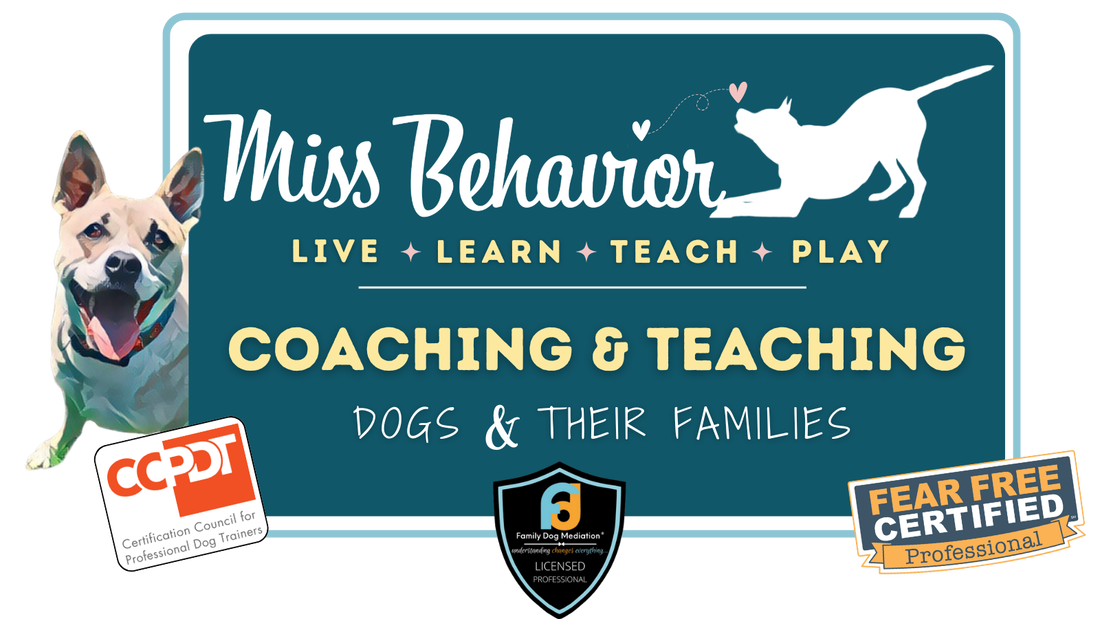|
7/24/2023 0 Comments Foundations of Better BehaviorStruggling with your dog's behavior?
I'm going to share my 5 Relationship-Focused Building Blocks to Better Behavior with you to help you figure out where you might be getting stuck and how to re-establish your foundation.
When it comes to training and behavior change in your living, breathing, 4 legged family member, there can be a lot of behavior problems that come into play. Whether you're dealing with fear of people, leash reactivity, fear of new places, separation anxiety, poor manners, barking, biting, noise phobia, fear of the vet, or are starting with a new puppy or dog... your relationship with your dog and with the behavior process is where it all begins. All behavior needs a solid foundation, built in trust, safety, and agency. There is no one size fits all solution but...
While there is no recipe to the complicated world of behavior, there certainly are important building blocks to build upon with your individual family and dog(s). As a Licensed Family Dog Mediator, my role is to help my clients personalize those building blocks and tweak them based on ever-changing needs and the nuances of behavior.
That being said, we all need to start somewhere. Let's take some time to go through the 5 relationship-focused building blocks to an enjoyable life with your family dog, looking at some questions you might want to ask yourself. While I'm not going to address all questions individually, I do think it's important to get a feel for the way in which you may want to think about approaching some of the sample questions... 1. Understanding
Before we jump into the questions, I do want to take a minute to talk about the training and behavior industry as a whole. When it comes to raising another living being and especially a non-human one, it can quickly become overwhelming. We can get stuck in a never ending maze of rabbit holes, which can be hard to escape from. The truth is, in the unregulated industry of dog training, anyone can call themselves an expert. While it can be hard to know who to listen to or who to follow, there are a few guidelines that can be helpful. First, you can look towards the regulation in the Veterinary Industry. In the US, we have the AVMA (American Veterinary Medical Association) and the AVSAB (American Veterinary Society of Animal Behavior). Both organizations play an integral role in staying on top of training methods, tool use in animals, studies on behavior, ethology, and more. If you are dealing with a behavior problem, those are the organizations you want to go through to find a Veterinary Behaviorist. They also have a position statement out on Humane Dog Training, which discusses evidence-based information on different training methods. All this to say, if you are questioning which experts to follow, you’ll want to be sure their methods are following those position statements. Spoiler alert: “Based on current scientific evidence, AVSAB recommends that only reward-based training methods are used for all dog training, including the treatment of behavior problems.”-AVSAB 
Going back to Understanding your dog, here are some questions you might want to ask yourself: Is my dog in an emotional or learning state right now? A dog who is feeling emotional is not going to be able to think and learn. When addressing behavior, asking your dog to actively do something while emotional, is not going to work. There’s actually a risk of worsening the behavior due to our common response to our dogs not listening. For example: Our frustration, our tightening of the leash, our tone of voice, and our lack of predictability can all play an important role in our dog’s continued emotional state. What's triggering my dog? Understanding your dog’s triggers is important not only so you can avoid the bigger triggers before they happen but also because of a phenomenon called Trigger stacking, which is what happens when multiple smaller triggers stack up over the course of the day. At some point, we just can’t take another trigger and may “boil over”. This can sneak up on us with our dogs, unless we can recognize those smaller triggers and the body language our dogs are showing us that indicate building stress. Why is one day better/worse than another? We all have our days. Whether due to fluctuating hormones, trigger stacking, chronic stress, poor quality sleep, etc. Our dogs have those days too! It doesn’t mean you are doing anything wrong but if our dogs start having more bad days than good ones, it’s important to see that and to look at what could be going on. Why is my dog more reactive to A than B? It’s hard to say WHY our dogs have issues with one trigger over another but it’s important to recognize that it happens and what’s triggering is up to our dogs, not to us. Do I understand the genetic needs of my individual dog? Puppies are not born as clean slates. It’s important to recognize that every individual puppy has thousands of years of learning in his genes. Individual breeds have individual needs and mixed breeds are no exception. While their genetic needs may be a bit … diluted… they are still there. Understanding your dog’s genetics can go a long way to helping you understand them. If you have not yet read it, I would recommend reading “Meet Your Dog” by Kim Brophey for more information on the different groups of dogs and how to best understand each one. Before moving forward with any intentional training or behavior change, it’s essential to be able to answer most or all of those questions. 2. Meeting Needs
When it comes to meeting needs, I’m not only referring to your dog’s needs. I’m talking about the whole family. While it’s important to consider your dog’s needs and I’ll discuss that more in depth, please know that I also want you to be sure you are filling your own cup. When working with a dog who has more needs than you expected him to, it’s easy to put your own needs on the back burner because of the commitment you made. It’s normal to feel regret, sadness, or even resentment towards your dog and if that’s happening, please don’t hesitate to seek out a support system for yourself. That may mean seeing a professional for your own mental health, talking to trusted friends and family, and/or seeking out some pet professionals who can help you handle some of the training or exercise load. It’s also extremely common for one family member to be the primary caretaker while other family members either don’t offer support or even add to the stress (due to their own resentment). Again, please seek out help if this is the case! 
When it comes to meeting your dog’s needs, here are some questions to consider:
What is my dog's body language saying? How fluent am I in reading the more subtle signals? Do my non-verbal cues match my verbal cues? Am I giving off clear body language that my dog can understand? Is my dog ACTUALLY comfortable right now? How do I know? How can I meet my dog's physical and mental needs? Have I addressed any new behavior problem with my dog’s Veterinarian? Have we ruled out underlying medical issues? 3. Management & Mindset
Mindset matters in all things when it comes to raising your dog. Setting expectations and then assessing why we have those expectations is an important piece of the journey. Think about an expectation you have about your dog. Then ask yourself why you have that expectation. Does that expectation help you and your personal family or is it one that has been set by someone else or by a story you’ve been taught to believe? Often, we set high bars for our dogs based on the expectations that we believe others have. We think we have to train our dog to do “all the things” - to greet politely, to come when called, to heel next to us on leash, to not bark at visitors, to love children, and so on. Maybe we believe that because that’s the dog we remember growing up. Maybe we believe that because we see it on the media. Maybe we even believe it because we’ve met those dogs, recently. But which of those things actually matters to you and your family. Do you want your dog to do those things because YOU think it’s important or would it be okay to just use management for a while and triage the things that actually matter to your family? Would that help lessen the burden a bit to know that 1. You did not cause the behavior, 2. You do not need to fix the behavior right now, and 3. You’re doing the best you can with the tools and resources you have available to you right now. That means that even if something you did led to worsening of the behavior, you didn't do it intentionally. I know that because you wouldn't be reading this if that were the case. You have my permission to just manage the environment as much and as often as you need to. 
Here are some questions to consider:
Did I cause my dog's behavior? Did I do so intentionally or was it because I was trying my best but simply didn't have all the information I needed? What if I'm too tired to train? Can I just manage the environment to get through the day? Am I giving my new dog the right amount of attention? Does my third dog really need the same amount of attention as my first dog? Can I substitute some of that attention with enriching toys and environmental things? Why doesn't my dog listen to my kids? Does it make sense that my dog may not understand what my kid is asking? Do I always understand what my kid is asking? Can I manage the environment to make things easier on everyone? 4. Intentional Skill Building
When it comes to building the skills of better behavior, progress will only happen if you and your dog are both able to receive, understand, and remember information. That type of learning doesn’t happen when you’re in the middle of a stimulating or distracting situation.
One of the biggest mistakes people make is trying to teach their dog a new skill IN the context where it will ultimately be needed. Just like we wouldn’t learn to swim in the deep end, we also shouldn’t be teaching or trying to use a skill that has not yet been taught to proficiency in a calmer, quieter, and less stressful environment (for everyone). I get it. Sometimes we think the skill has been taught well enough and sometimes we’re in an emotional state ourselves and can’t help but ask our dog to do the thing we need them to do, with the hope that it will work in the moment. For example - your dog just ran out the door. You panic and call your dog to come. He doesn’t listen. Why? Because he’s not proficient at that skill yet outside the yard, when given the opportunity to run and explore. So what can you do? Rely on management. Make sure your dog doesn’t have the opportunity to escape WHILE you work on that skill. But what if your dog gets out the front door anyways? You’ll do better to fall back on other skills that your dog probably has naturally learned. Many dogs will chase us if we run away. Many dogs will come to the sound of crinkled bags or squeaky toys… the car door being opened… the doorbell being rung. This is because it’s a skill that has been built up, even unintentionally. You’re here now so NOW is the time to consider what skills you need to work on with your dog pro-actively. 
Grab the Building Blocks PDF GuideGrab the PDF guide, full of audio training, games, and easy human-learning tasks to get you going on the right path! Thank you!Check your email for the guide! 
Here are some questions to consider: Which skills would benefit my individual dog? Don't think about what your sister has taught her dog or what your neighbor down the street needs. Think about your own individual dog. Set your priorities. Do I need to train my dog to do "all the things"? Spoiler alert: No, you don't. How do I teach a new skill? This is where you'll want to reach out. I have a huge library of video lessons in my membership or there are many great positive reinforcement based video lessons that can be found on YouTube. Just remember that every dog learns things differently. Don't compare your dogs experience to the one edited on the video. How often should I practice? Quality over quantity. You're better off practicing in short successful sessions than practicing for too long with more frustration or less success. 5. Problem Solving
After moving through all other building blocks, you get to problem solving. Why is this the final piece? Because life happens. Problems arise. Your dog is an individual and so are you. So is your family and your environment. This means that what works for one dog isn’t going to work for the next so it’s important to be able to evaluate where you’re stuck, what you could change, how to help. This is why it’s important to work with a professional who can assess your dog, your family, and mediate - helping you get your building blocks set without too much lost time or frustration in the process. 
When problem solving, here are some questions to consider:
How do I know when to increase or decrease difficulty? You'd be better off going too slow than too fast but often we can overthink that, as well, and need to be nudged just outside our comfort zone to make progress. When does the training end? Does it end? How do I make a training plan? Where should I start? What if we have a set back? Is it a lost cause? When and how do I wean off the treats? What if my dog is still relying on them? 
Grab the Building Blocks PDF GuideGrab the PDF guide, full of audio training, games, and easy human-learning tasks to get you going on the right path! Thank you!Check your email for the guide!
0 Comments
Your comment will be posted after it is approved.
Leave a Reply. |
|
- Home
- About
- Blog
- Services
- Membership
-
Courses & Freebies
- All Courses
- FREE Boredom Buster Recipes
- COURSE: Building Resilience in your Family Dog
- COURSE: Managing the Leash Walk
- Potty Training COURSE
- Paws Off COURSE
- COURSE: Managing the Leash Walk
- FREE Attention Building Challenge
- FREE Scratchboard Training
- FREE Rest and Recovery Round-Up
- FREE Body Language 101
- Contact
- Home
- About
- Blog
- Services
- Membership
-
Courses & Freebies
- All Courses
- FREE Boredom Buster Recipes
- COURSE: Building Resilience in your Family Dog
- COURSE: Managing the Leash Walk
- Potty Training COURSE
- Paws Off COURSE
- COURSE: Managing the Leash Walk
- FREE Attention Building Challenge
- FREE Scratchboard Training
- FREE Rest and Recovery Round-Up
- FREE Body Language 101
- Contact
Search by typing & pressing enter



 RSS Feed
RSS Feed





